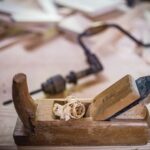Introduction
As a woodworker, having the right tools is essential for creating beautiful pieces of furniture and other crafts. It’s important to understand which tools are necessary to use and how they should be maintained to ensure they last. Here’s a list of some basic tools you will need to get started on your woodworking journey.
The first tool every woodworker should have is an adjustable combination square. It can be used to accurately mark measurements and angles, plus it can double as a straight edge or depth gauge. A good saw is also essential; either a hand saw or circular saw will do. A drill is also an important addition ” cordless drills offer more freedom of movement around the workplace, but corded models tend to be easier for drilling large holes. Lastly, clamps are indispensable for holding two pieces together securely so that you can make accurate cuts with your saw or drill. Be sure to buy quality clamps that won’t break down from wear and tear over time ” many professional woodworkers recommend buying metal-and-wood bar clamps designed specifically for woodworking projects.
Essential Tools Every Woodworker Needs
No woodworking project is complete without the right tools. While there are a variety of tools available to help complete any task, there are some that are an absolute must for every woodworker. Here is a list of the best tools for woodworkers:
Table Saw: This is perhaps the most essential tool as it can make most cuts a woodworker needs. It features a circular saw that is driven downwards through the board at high speeds, which allows for precise cuts without causing much force or damage to the material used.
Drill Press: The drill press offers more control over drilling than any other power tool and can be used to bore holes more accurately into lumber and other materials. Additionally, its adjustable head makes it great for drilling into boards with different thicknesses and shapes.
Router: This versatile piece of equipment gives you precise control when trimming away excess material from your project or shaping edges and surfaces. There are several router models designed specifically for trimming and routing composite materials like fiberboard and particleboard as well.
Sander: Sanders make quick work of flattening, sanding, buffing, and finishing just about any surface; from rough planks to delicate furniture pieces. For those who need very precise results on finer materials such as veneers, dustless sanders such as those powered by compressed air, offer superior accuracy and maneuverability with minimal fuss or mess.
Clamps: Most woodworkers wouldn’t dream of working without clamps! Using clamps helps ensure accurate joins while keeping glue-up neat and precise without any gaps or misaligned pieces. Clamps come in all shapes and sizes so having multiple sizes on hand will save you time in finding the right set up for every project you tackle!
Electric Power Tools
When it comes to power tools for woodworking, electric power tools can provide a lot of convenience and efficiency in the workshop. They are typically much faster at cutting, sanding, and drilling than traditional hand-held tools. This can make tackling larger projects easier and mean less time spent in the shop. Additionally, electric tools tend to last longer than manual hand tools since they do not require as much strength or physical exertion while they are being used.
However, there are some disadvantages associated with electric power tools. They tend to be more expensive than manual hand tools due to their higher quality parts and technology required for their operation. Electric power tools also require some maintenance such as oiling and cleaning in order to keep them performing optimally. Finally, if you do not have access to an electrical outlet in your shop area, you will need to purchase a separate generator or battery-powered tool which can add additional costs onto your project budget.
Hand Tools
When it comes to woodworking projects, hand tools are essential. There are many different styles and types of hand tools available for woodworkers, but it can be confusing to figure out which one is best for a specific project. The most common styles of hand tools are chisels, saws, planes, mallets, and knives.
Chisels: Chisels come in various shapes and sizes and can be used to shape grooves or cut away unwanted material from a piece of wood. They can also be used to mortise joints or trim tenon shoulders. Typically, a quality chisel set consists of five pieces including three standard sizes as well as a gouge and a few paring chisels.
Saws: Saws are an integral part of the woodworking process and come in many forms such as rip saws, crosscut saws, coping saws, panel saws etc., all designed specifically for cutting different types of materials. Hand operated saws are one option while the use of power-operated ones has become increasingly popular with professional woodworkers over recent years.
Planes: Planes work by thinning out or flattening the surface of a board or piece of timber by taking small slices off the surface at regular intervals while leaving an almost even finish on the surface area covered. Bench planes, smoothing planes and block planes are some options available for achieving this goal.
Mallets: Mallets normally have wooden heads which make contact with the surface being worked without causing excessive damage”often allowing delicate work like carding linen cloth or fashioning intricate carved objects possible”with traditional models made from hardwoods like boxwood or apple tree wood (or plastic in recent times).
Knives: Knives help with countless tasks throughout a wide range of applications including joinery (dovetails), marquetry (pattern cutting), carving (3D shape making) and overall tool maintenance among others”each having its own specialized blade design to better handle specific tasks at hand with models varying between classic French utility knives to custom pattern knives laden with multiple blades designed to take up less space when not in use.
Woodworking Clamps
Woodworking clamps come in a wide variety of types and sizes, each suited to different tasks. Commonly used are bar clamps, which secure material against the edge of a worktable or between two other pieces of wood. These particularly lend themselves to longer projects such as cabinetwork that require more than one piece joined together. Pipe clamps act similarly to bar clamps but are less likely to damage fragile materials due to their wider surface area. Another variety of clamp is the handscrew, shaped like a giant pair of pincers that secure irregular shapes or edges without marring them. A strap clamp also allows for non-marring fastening as it is a lengthier version of a pipe clamp and thus can wrap around bigger objects such as large furniture pieces or oddly shaped spaces for securing two points together with adjustable tension. Smaller projects or items with delicate surfaces might benefit from the smaller form; known as spring clamps, these function like smaller versions ofstrap clamps and are often plastic coated to prevent damage caused by metal contact. C-clamps are also commonly used across varieties of disciplines due to their varying sizes, allowing them strong functionality in fixing and assembling several components together with adjustable force when needed most importantly, they have excellent holding strength even after repeated use.
Tool Storage Solutions
Tool storage is an important and often overlooked part of any woodworking shop. The right organization means maximizing space, using existing space efficiently, and having what you need available when you need it. It also promotes safety by reducing the risk of overloading shelves and making sure that tools are stored in the proper place when not in use.
The first step to tool storage is determining the specific needs of your shop. Consider the types of items that you have most often or use most frequently”these should be easily accessible and labeled so that they can easily be found, especially in a hurry. Then think about how much storage you need for other tools such as saws, chisels, and drills. Make sure each type of tool has its own designated area, with accessories stored in a way that allows you to easily find them when needed.
For larger pieces, mount heavy wall cabinets or pegboards to keep tools off of the floor. This helps reduce clutter and makes it easier for woodworkers to move around their workshop without tripping over anything. If needed, installing customized racks or shelving can free up more space for less Frequently used items like specialty jigs or Power Tools. Finally, it’s essential to secure all hazardous chemicals on a high shelf away from important equipment – When properly organized with care and attention to detail, everyone can benefit from a well-run shop.
Power Sanders
Power sanders are essential tools for any woodworker. There are many varieties of power sanders, each designed specifically for different applications. Belt sanders are heavier and more powerful than other types, making them well-suited to rough or large-scale sanding projects. Orbital sanders have round-base plates that give the tool an oscillating motion, which is good for smooth finishes on surfaces like decks and walls. A random orbit sander has a combination of rotary and orbital motion, making it ideal for leveling uneven surfaces. Detail sanders use triangular base plates that fit into tight corners and crevices easily, which make them great for small projects and intricate work. Palm sanders finish off the list with their small size and light weight; ideal for more delicate tasks such as fitting molding around doors or windows.
When using one of these tools, it is important to choose the right grit size that best suits your project. Coarser grits (between 40-80) should be used when removing old finishes or preparing rough surfaces while medium (100-150) or fine (180-220) are better suited to achieve finer finishes. With proper use, power sanders can help you create a smooth professional finish in a fraction of the time! Best practices also dictate wearing safety glasses while working with any type of power sander, as dust accumulation could affect your vision if not properly protected against. Additionally, wearing a dust mask is recommended to protect lungs from particles created when sanding; this will especially come in handy when working with materials such as MDF or particleboard that produce more particulate matter during the process. Lastly, hold the power sander securely but firmly when using in order to prevent any accidents occurring due to excessive vibration from the motor or any creative movements catching you off guard – this holds true regardless of experience level!
Table Saws
Table saws are a must-have tool for any woodworker. These powerful cutting tools provide an efficient way to make precision cuts on a variety of materials, allowing you to create complex shapes and designs quickly and easily. With the right table saw, you can rip, crosscut, and miter with ease, making all sorts of projects possible.
To ensure the safest and most effective use of your table saw, it’s important to consider your needs carefully before investing in the best option for you. Think about factors like the size and weight of the job you plan to do; whether or not portability is important; what type of blade will be needed (carbide or diamond); how much power is needed; how accurate the cut needs to be; and safety features such as electric brakes or guard systems. Additionally, don’t forget about other features you may need such as onboard dust collection systems or even computerized readouts.
Once you have chosen a model that suits your needs, be sure to read through the user manual before turning on your machine. Note any special requirements specific to your new saw ” such as choosing specific blades designed for that particular type of machine working with certain materials ” then take time to get familiar with every aspect. It’s also important to understand all safety procedures as outlined in the manual, including working with proper hearing protection; wearing eye protection while near your saw blade (either a face shield or safety glasses); and understanding basic power tool safety principles like being sure everything is properly secured during use. Don’t forget that keeping the work area clean around your table saw will help ensure better performance from your machine over time. Finally, regularly inspect both table saws components as well as accessories for signs of wear or damage – replacing parts as necessary – which can reduce any potential accidents due their failure later down the line.
Finish Work
As a woodworker, having the proper tools and supplies for any given project is paramount to achieving excellent results. Finishing a wood surface is no exception, and there are certain products and practices that will produce a professional look. A few of the best tools for woodworkers include sanders, sandpaper, wood fillers, clamps, sanding blocks, brush rollers and tack cloths.
For detailed jobs such as paneling or cabinetry, sand paper provides consistent results whether it’s used with a sander, a hand block or by hand. Sanding blocks come in various shapes and sizes which allow them to work in nooks and crannies. Sandpaper grades of medium-fine (150 to 320 grit) are ideal for general smoothing and finish preparation while finer grits (400 to 600) provide an even finer finish prior to the staining of the surface. Another effective finishing tool is a brush roller; this specialized sliding tool does not leave tracks on the surface like traditional paint rollers can. A clean finishing cloth or tack cloth helps to get rid of sawdust based residue prior to applying any protective layer such as varnish or shellac. Lastly, wood fillers are immensely useful when it comes to fixing large gaps and uneven surfaces in between two pieces of timber; these should be applied before additional sanding takes place for maximum effectiveness. With these basic components any aspiring craftsman has all they need in order to yield quality finish work on a variety of projects.
Health and Safety Tips
When woodworking, it is important to be aware of the potential risks and practice safe working habits in order to prevent hand, eye, and other common injuries. Here are some tips on how to avoid common injuries when working with tools:
1. Select the most appropriate tool for the job: Using an inappropriate tool for a job can lead to dangerous accidents or even create hazardous conditions. Be sure you’re using the right tool before beginning any project.
2. Maintain your tools: Make sure your cutting blades and edges are always sharp as dull blades can be forced, leading to slips and kicks back that could cause serious injury. Dust off your tools regularly so you don’t end up accidentally pushing them into something hard or hazardous.
3. Wear proper safety equipment: You should always wear gloves to protect your hands from cuts and protect your eyes with certified safety glasses; these will help you prevent accidents while woodworking. Also make sure your clothing is breathable and fits properly so that it won’t snag onto anything or get caught in a machine’s cupboard locks and chainsaw chains.
4. Work in an area that has good lighting: Having enough light helps you do accurate work, eliminating any chance of making a wrong cut due to poor sight lines or missing something important during assembly of parts beforehand. Additionally, keep walkways clean, secure cords away from walkways, and make sure all stairs are clear of clutter or uneven surfaces that might increase the risk of tripping or slipping into machinery or other potential hazards.
5. Practice patience when working with machinery: Don’t rush through tasks when handling machines ” take breaks if necessary and refer back to the manual before making any adjustments in order to reduce risks associated with incorrectly setting machines up or forgetting vital components such as blade guards. When possible try not to overreach into moving mechanical parts as this can lead to unexpected starts of motors which can cause whiplash type injuries even fatal ones such as getting entangled in rotating parts not meant for contact with human skin/hands/clothing etc..
Conclusion
For many woodworkers, investing in quality tools is one of the best ways to guarantee success. High-quality woodworking tools are durable, reliable and easy to use. Not only will they last for years, but they’ll help you create works that look great and stand the test of time. Investing in quality tools also cuts down on wasted materials and reduces overall production costs. With the right tools and some ingenuity, anything you create with wood can turn into a beautiful work of art.
Choosing which types of woodworking tools are best for your projects can be tricky. Research different brands, read reviews online and take advice from experienced woodworkers if possible. Investing in quality tools for your craft means spending money upfront ” but it will translate into greater savings over time. Choose wisely and enjoy creating beautiful pieces that you won’t have to rework or replace any time soon! Conduct regular maintenance on your tools as well, keeping them clean and lubricated to ensure optimal performance throughout the years. With these tips in mind, you can become a masterful woodworker by investing wisely in quality equipment for every project.

Hi everyone! I’m a woodworker and blogger, and this is my woodworking blog. In my blog, I share tips and tricks for woodworkers of all skill levels, as well as project ideas that you can try yourself.





